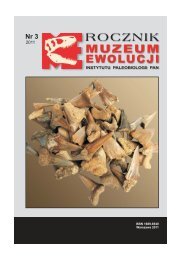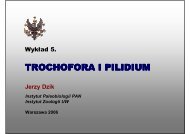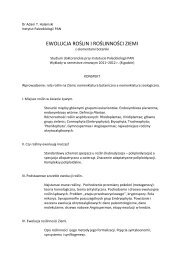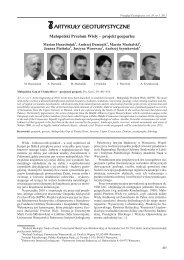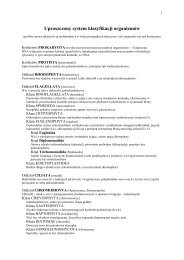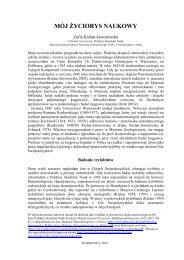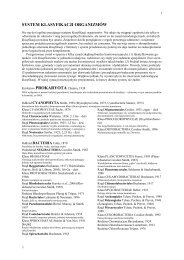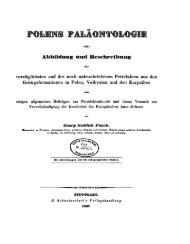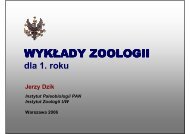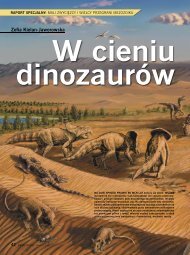peÅen tekst - Institute of Paleobiology, Polish Academy of Sciences
peÅen tekst - Institute of Paleobiology, Polish Academy of Sciences
peÅen tekst - Institute of Paleobiology, Polish Academy of Sciences
Create successful ePaper yourself
Turn your PDF publications into a flip-book with our unique Google optimized e-Paper software.
Zapis kopalny biozróżnicowania<br />
przegląd historyczny jest żałośnie niekom−<br />
pletny. Nie zostało w nim omówionych wiele<br />
tematów związanych z historią biozróżnico−<br />
wania zwierząt morskich. Nie mniej jednak,<br />
nawet taki wybiórczy opis tego, co wiemy na<br />
temat historii biozróżnicowania, ujawnia sto−<br />
pień niepewności, który ogranicza nasze zro−<br />
zumienie historii życia w ujęciu czysto ilościo−<br />
wym.<br />
Oczywiście, zdajemy sobie sprawę z try−<br />
wialnej prawdy, że w dzisiejszych oceanach<br />
musi żyć znacznie więcej gatunków zwierząt<br />
niż u zarania ewolucji świata zwierzęcego. No<br />
bo przecież u początków życia wielokomórko−<br />
wego, ponad 540 milionów lat temu, gdy tkan−<br />
kowce dopiero zaczynały się różnicować, nie<br />
mogło być mowy o milionach gatunków, tysią−<br />
cach rodzin i setkach rzędów zwierząt. Ale<br />
taka wiedza jest banalna. Bardziej interesujące<br />
byłoby ustalenie, w sposób rygorystyczny i iloś−<br />
ciowy, jak i kiedy wszystkie te gatunki się<br />
namnożyły. Tego jednak nie wiemy. Wiemy<br />
tylko, że trudno o jakiekolwiek pewniki w iloś−<br />
ciowych badaniach nad historią biozróżnico−<br />
wania. Zbigniew Herbert <strong>of</strong>eruje tu najlepsze,<br />
nawet jeśli niezbyt satysfakcjonujące podsu−<br />
mowanie: „pytania z pozoru proste wymagają<br />
zawiłej odpowiedzi”.<br />
Literatura cytowana<br />
Allison, P.A. i Briggs, D.E.G. 1993. Paleolatitudinal sam−<br />
pling bias, Phanerozoic species−diversity, and the end−<br />
Permian extinction. Geology 21: 65–68.<br />
Alroy, J. 2003. Global databases will yield reliable mea−<br />
sures <strong>of</strong> global biodiversity. <strong>Paleobiology</strong> 29: 26–29.<br />
Alroy, J. (w druku). Geographic, environmental, and in−<br />
trinsic biotic controls on Phanerozoic marine diversifi−<br />
cation. Palaeontology.<br />
Alroy, J., Marshall, C.R., Bambach, R.K., Bezusko, K.,<br />
Foote, M., Fürsich, F.T., Hansen, T.A., Holland, S.M.,<br />
Ivany, L.C., Jablonski, D., Jacobs, D.K., Jones, D.C.,<br />
Kosnik, M.A., Lidgard, S., Low, S., Miller, A., Novack−<br />
−Gottshall, P.M., Olszewski, T.D., Patzkowsky, M.E.,<br />
Raup, D.M., Roy, K., Sepkoski Jr., J.J., Sommers, M.G.,<br />
Wagner, P.J. i Webber, A. 2001. Effects <strong>of</strong> sampling<br />
standardization on estimates <strong>of</strong> Phanerozoic marine di−<br />
versification. Proceedings <strong>of</strong> the National <strong>Academy</strong> <strong>of</strong><br />
<strong>Sciences</strong> USA 98: 6261–6266.<br />
Alroy, J., Aberhan, M., Bottjer, D.J., Foote, M., Fürsich,<br />
F.T., Harries, P.J., Hendy, A.J.W., Holland, S.M.,<br />
Ivany, L.C., Kiessling, W., Kosnik, M.A., Marshall,<br />
C.R., McGowan, A.J., Miller, A.I., Olszewski, T.D.,<br />
Patzkowsky, M. E., Peters, S.E., Villier, L., Wagner,<br />
P.J., Bonuso, N., Borkow, P.S., Brenneis, B., Clap−<br />
ham, M.E., Fall, L.M., Ferguson, C.A., Hanson, V.L.,<br />
Krug, A.Z., Layou, K.M., Leckey, E.H., Nuernberg,<br />
S., Powers, C.M., Sessa, J.A., Simpson, C., Toma−<br />
šových A., i Visaggi, C.C. 2008. Phanerozoic trends in<br />
the global diversity <strong>of</strong> marine invertebrates. Science<br />
321: 97–100.<br />
Adrain, J.M. i Westrop, S.R. 2003. Paleobiodiversity: we<br />
need new data. <strong>Paleobiology</strong> 29: 22–25.<br />
Bambach, R.K. 1977. Species richness in marine benthic<br />
habitats through the Phanerozoic. <strong>Paleobiology</strong> 3:<br />
152–167.<br />
Bambach, R.K. 1999. Energetics in the global marine<br />
fauna: a connection between terrestrial diversification<br />
and change in the marine biosphere. Geobios 32:<br />
131–144.<br />
Bush, A.M. i Bambach, R.K. 2004. Did alpha diversity in−<br />
crease during the Phanerozoic? Lifting the veil <strong>of</strong><br />
taphonomic, latitudinal, and environmental biases in<br />
the study <strong>of</strong> paleocommunities. Journal <strong>of</strong> Geology<br />
112: 625–642.<br />
Carroll, M., Kowalewski, M., Simões, M.G. i Goodfriend,<br />
G.A. 2003. Quantitative estimates <strong>of</strong> time−averaging<br />
in brachiopod shell accumulations from a modern<br />
tropical shelf. <strong>Paleobiology</strong> 29: 381–403.<br />
Cherns, L.V.P. i Wright, P. 2000. Missing molluscs as evi−<br />
dence <strong>of</strong> large−scale, early skeletal aragonite dissolu−<br />
tion in a Silurian sea. Geology 28: 791–794.<br />
Erwin, D.H. 2006. Extinction: How Life on Earth Nearly<br />
Ended 250 Million Years Ago. 296 s. Princeton Uni−<br />
versity Press, Princeton.<br />
Gould, S.J. 1980. The promise <strong>of</strong> paleobiology as a nomo−<br />
thetic, evolutionary discipline. <strong>Paleobiology</strong> 6: 96–118.<br />
H<strong>of</strong>fman, A. 1979. Community paleoecology as an epi−<br />
phenomenal science. <strong>Paleobiology</strong> 5: 357–379.<br />
H<strong>of</strong>fman, A. 1985. Patterns <strong>of</strong> family extinction depend<br />
on definition and geological timescale. Nature 315:<br />
659–662.<br />
H<strong>of</strong>fman, A. 1989a. Arguments on Evolution. 274 s. Ox−<br />
ford University Press, Oxford.<br />
H<strong>of</strong>fman, A. 1989b. Mass extinctions – the view <strong>of</strong> a skep−<br />
tic. Journal <strong>of</strong> the Geological Society 146: 21–35.<br />
Holland, S.M. 1995. The stratigraphic distribution <strong>of</strong> fos−<br />
sils. <strong>Paleobiology</strong> 21: 92–109.<br />
35



